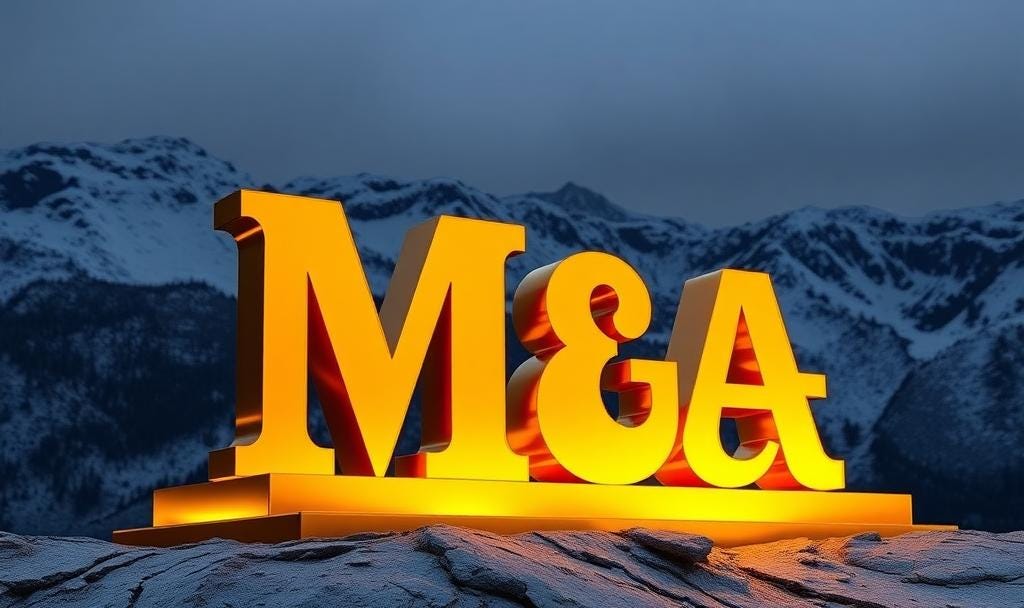Gold Deals Set to Dominate, but Value Getting Harder
Sector ‘screaming out’ for more consolidation, according to FT panel
While copper is high on many miners’ wish lists, bankers see gold dominating the deal landscape for the rest of the year and into 2026.
“Copper is at top of everybody shopping list, let’s face it, it has been actually probably for 10, 15, 20 years – nothing’s changed,” Jim Rutherford, director of Saudi-backed Manara Minerals told the FT Metals and Mining Summit in London on Friday.
However, he expects gold to dominate deal flow over the next 12 months.
“Gold is an industry that’s just been screaming out for consolidation,” Rutherford said.
“There’s been a lot of lifestyle companies in that industry.”
Standard Chartered global head, metals & mining Richard Horrocks-Taylor agreed that there were some lifestyle companies in the gold sector.
“Now, is the moment, if you’re looking to sell in the next five to 10 years, you’d look at that seriously now,” he said.
“I think we are seeing quite a few deals coming forward on the gold side, so I think the fourth quarter is going to be strong.”
More asset-level deals?
Alix Partners partner and managing director Hassan Morsy pointed to research which suggested that 70% of the mining deals of over US$3 billion in the past decade destroyed shareholder value, a statistic he described as “quite frightening”.
“Then we see another very different kind of theme, which is, if you look at the top 50 companies trading in mining, and you want to look at what was the top quartile performer, the top quartile performers are the ones that did asset-level transactions,” he said.
Morsy said the companies over the past decade that were regularly doing asset-level transactions tended to be more agile.
“We think that definitely scale is important, so consolidation is important, but up to a certain level, right? Because you need to be quite agile,” he said.
“M&A is going to be important, but we do believe, just looking at fact, in the last 10 years, the winners were the ones that did lots of good asset-level transactions, more than big, north-of-US$3 billion M&A.”
White & Case partner Rebecca Campbell said deals would continue, not only in gold, but there was a change in the type of transactions.
“Almost all of those we are seeing are either single-asset deals of pre-production assets or near-production assets and strategic joint ventures,” she said.
Zijin the model
Horrocks-Taylor said a company that had been hugely successful in doing asset-level deals was Zijin Mining (SH: 601899).
On Friday, Zijin’s newly listed spin-off Zijin Gold International (HK: 2259) completed the US$1.2 billion acquisition of the Raygorodok gold mine in Kazakhstan on Friday, its eighth gold deal since 2020.
The company also acquired the Akyem gold mine in Ghana from Newmont Corporation (NYSE: NEM) for US$1 billion earlier this year.
“I think we’ve been seeing for many years, Zijin, every year, doing one or two transactions at the asset level,” he said.
“If you’re the bank on the sell side, they’ll take your model and throw it in the bin. They basically do their own technical work. The chairman is a geologist, which has helped.
“In China, SOEs historically, were seen to be, particularly the most senior level on the governance side, sort of not on top of the detail, but I think with Zijin, they’ve really developed a phenomenal M&A capability, and use the M&A around the asset level, along with their own technical capabilities and their ability to bring in IP and expertise into these assets so they can build them more cheaply and effectively, they can drive shareholder value.
“I think the asset-level piece is definitely there, and I think Zijin is an example of someone who’s harnessed that, and they’ve been doing that for the last 10 years, where many of the majors didn’t do deals for five or six years, because they were in the doghouse a little bit for what they did back in 2012-2013 at the back end of the super cycle.”
The question of value
Ninety One portfolio manager George Cheveley said the gold price was rising so rapidly, it was hard to pinpoint value.
“The move in price obviously puts people off to some extent,” he said.
“You hear people are trying to sell assets or things, and the bid’s coming in a week out of date, and they’re like, ‘sorry, look at the price now, and maybe it’s going to stay here, so let’s reprice it’.”
Cheveley said there were many gold miners doing well but were depleting their reserves quickly.
“Those companies, if they haven’t found anything, are going to start to get desperate next year, looking for reserves, and obviously the fastest way to get them is go buy them,” he said.
“It doesn’t necessarily add a lot of value, but I think that could well start to encourage some deal-making next year.”
The spot gold price broke through US$4000 an ounce late last week and is now trading above US$4120/oz.
“There’s an interesting technical issue in the gold market, in terms of deals, is that we’re looking at the biggest differential ever between the spot price and the price at which reserves are valued,” Rutherford said.
“Newmont, in its latest reserve statement, valued them at US$1700, which in itself, was a big uptick from the year before, so the gap between spot and reserve valuation, the US$2300, is actually bigger than the actual absolute gold price was 12 months ago.
“So what price do you use in terms of value of a gold deal in that sort of environment?”


